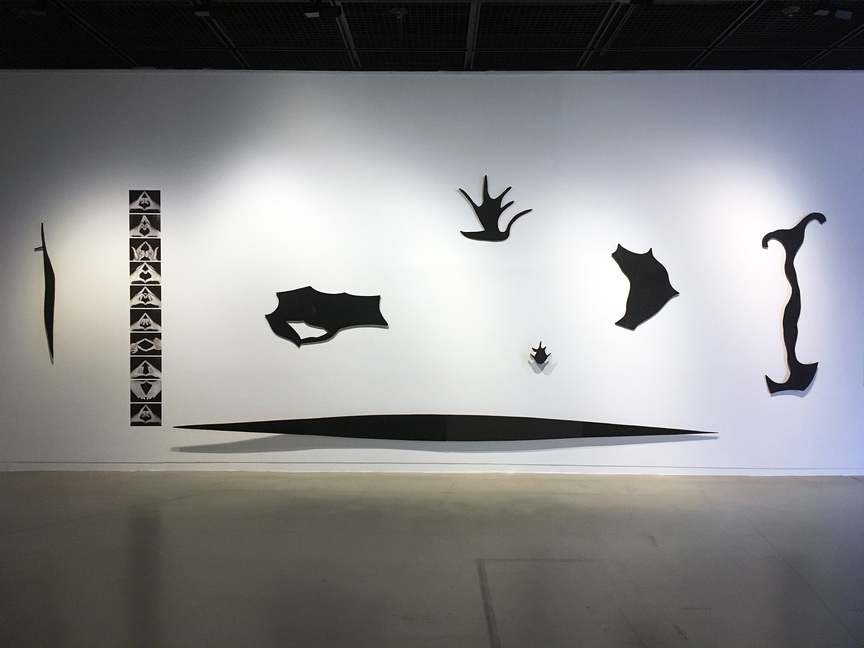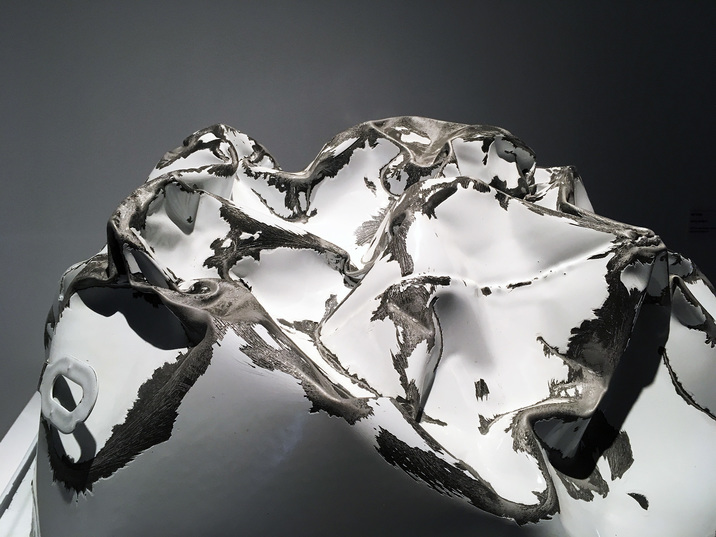-
From Current Issue
-
- Editor’s Letter Fire in the Heart
- Reviews I Gusti Ayu Kadek Murniasih
- Reviews 11th Seoul Mediacity Biennale: “One Escape at a Time”
- Dispatch Networked China
- One on One Monira Al Qadiri on Yukio Mishima
- Essays The rise of independent art spaces in pandemic-era Shanghai
- Features Tuan Andrew Nguyen
- Table of Contents
- Web Exclusives
- Archive
- Subscribe

R
E
V N
E
X
T
Installation view of “Focus Kazakhstan – Eurasian Utopia: Post Scriptum” at the Suwon Ipark Museum of Art. Courtesy Focus Kazakhstan.
“Eurasian Utopia: Post Scriptum” at Suwon’s Ipark Museum of Art was the final exhibition in the “Focus Kazakhstan” series—a global statement displayed in London, Berlin, New York and Suwon. The state-funded project was initiated shortly after Kazakh president Nursultan Nazarbayev published his article “Course Towards the Future: Modernization of Public Conscience” in April 2017. Here, Nazarbayev discusses the need for a robust Kazakh “national consciousness” even as the country seeks to extend its political and economic engagement with other parts of the world. Though Nazarbayev has enacted various soft-power policies since the country’s post-Soviet independence, the exhibitions marked the first time that the government has seriously considered contemporary art as a means to project and legitimize an image of Kazakhstan as a modern nation abroad.
“Eurasian Utopia,” co-curated by Yuliya Sorokina and Eun Young Shin, resisted the facile, idealized national narratives so often peddled by states, pivoting instead around the question: What is the collective image of Kazakhstan? As the show elucidated through its chronological display, many factors have influenced Kazakh identity, a major one being its Soviet legacy. In 1954, Nikita Khrushchev launched the Virgin Lands campaign, which aimed to address food shortages across the USSR by transforming the steppes into arable land. This period was represented in the exhibition by several paintings that demonstrate art’s propagandistic uses, including Aitymbay Moldabekov’s The Earth (1974), a portrait of two workers sitting on a stretch of rich soil, the thawing snow receding behind them; Vladimir Eyfert’s The Storming of the Virgin Soil (1954), of a row of tractors plowing through a green field; and Maris Khitakhunov’s Bread (1965), depicting a woman and a girl with a platter of sustenance. Notably, the Virgin Lands campaign brought workers from Russia and Ukraine to Kazakh lands, adding to the diverse ethnic groups who had been deported there by Joseph Stalin between the 1930s and ’50s, as well as the nomadic peoples that had been violently sedentarized beginning in 1928. In the show, Mikhail Kim, who is of Korean descent, testified to the layers of personal and national identity that Kazakhs have to navigate with his oil painting Fan (1980), featuring hanbok-sporting female dancers.
The curators spotlighted a syncretic view of the country, put forward by “father of Kazakh contemporary art” Rustam Khalfin (1949–2008), whose conceptual framework (and the show’s namesake), “Eurasian Utopia,” blended local, nomadic and global ideas. Khalfin’s importance was signaled by the display of several of his works, including the wall-based installation Pulotas (2004). Featuring two-dimensional black shapes representing the negative spaces found between limbs and digits when the body is in various positions, the work was inspired by the notion of the void but also everyday gestures, such as when nomads squeezed the curds of their traditional cheese. Khalfin’s approach—probing one’s culturally unique perspective by looking both inward and outward, toward past and future—was embodied in other works. Sergey Maslov’s rocket-shaped yurt, Baykonur 2 (2002), which houses a TV monitor showing photoshopped images of Kazakhs with aliens in space, posits that extraterrestrial beings once hid their spaceships among traditional nomadic dwellings. Elsewhere, Aida Adilbekova reinterprets a Kazakh myth about a witch who kills people with her nails. In the artist’s performance, Jeztyrnaq (2018), she axes off the long metal nail extensions on her fingers while she sings the folktale, suggesting an end to the story’s violence.
Other artists examined the region’s political transformations in recent history. Lenin Peak (2007–14)’s titular subject is rendered via inverted, white washing-machine shells, which were partially scrubbed and hammered. Lining up three of these mountain summits, Yerbossyn Meldibekov gestures to the many names given to Lenin Peak—located on the border between neighboring Kyrgyzstan and Tajikistan—which were all endorsed and then effaced by a rapid succession of leaders. Commenting on Nazarbayev’s 2018 decree to reverse the Russification of the Kazakh language by transitioning from a Cyrillic to a Latin alphabet, Yelena and Viktor Vorobyev’s four-part, mixed-media painting Global Text (2018) shows a flock of sheep wandering across a snow-blanketed expanse. Each of the animals is marked with a black Latin letter; in one part of the painting, such letters surreptitiously spell out, “To be or not to be.” “Focus Kazakhstan” recognized that the narratives we tell ourselves inform who we are and how we live—the question is whom do we permit to shape the story?
YELENA AND VIKTOR VOROBYEV, Global Text, 2018, oil on print on four canvases, each 160 х 240 cm. Courtesy the artists and Aspan Gallery, Almaty.
Chloe Chu is ArtAsiaPacific’s associate editor.
“Focus Kazakhstan – Eurasian Utopia: Post Scriptum” is on view at Suwon Ipark Museum of Art until March 3, 2019.
To read more of ArtAsiaPacific’s articles, visit our Digital Library.




















